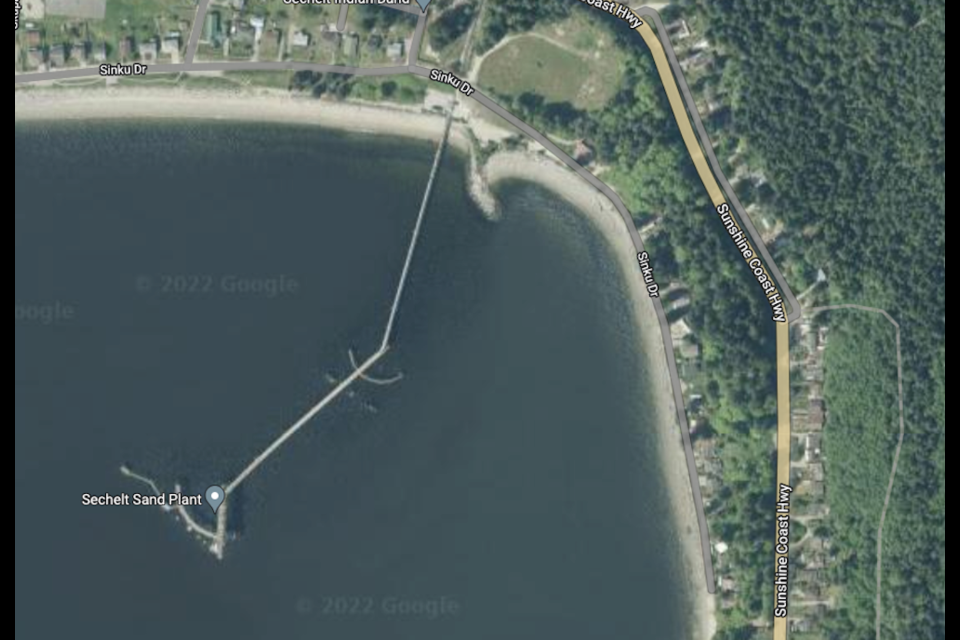More than a dozen households on shíshálh Nation land have been told they will need to evacuate their oceanview homes on lower Sinku Drive, and what’s left will be demolished.
On Monday, July 18, shíshálh Nation told residents of lower Sinku Drive near Sechelt’s Trail Bay they have three to nine months to leave their homes. A press release posted on shíshálh Nation’s Facebook page on July 21 said a comprehensive geotechnical assessment of the residential area of lower Sinku Drive has identified “safety concerns with regards to ongoing residential occupation of the affected properties currently occupied by shíshálh Nation members.
“After consultation with available experts and resources, for the safety of all residents, Council has directed staff to assist the residents of the identified properties with finding alternative housing as soon as possible,” the release states.
In an interview on July 22, hiwus (Chief) Warren Paull confirmed that 17 or 18 homes, housing approximately 50 people, need to be evacuated in the coming months.
The area in question includes land leased from the Nation to the homeowners from just north of the breakwater to around where the Lehigh off-load facility is located. The graveyard also has potential for failure. The survey, Paull said, indicated the impacted area is relatively localized and, to his knowledge, Highway 101 is not impacted. The Lehigh conveyor facility was built to meet the requirements of that slope area, he added.
Concerns for the area go back to 2016, when a geotechnical survey for the now under way subdivision near Selma Park included comment about potential instability of the slope of the foreshore area. In 2020, shíshálh Nation commissioned a boundary consultant to put together information about the risks to that area. That report came back in June, Paull said.
“The survey is fairly clear in the sense that while nothing has happened to date, should there be a seismic event, there's very real potential for the slope to be unstable and envelop the homes,” Paull told Coast Reporter.
Council began conversations with the provincial and federal governments about what support the Nation could garner. Those conversations are ongoing, and a bit of a “catch-22,” Paull said, as the people who respond to such events usually wait for the events to happen.
“From my perspective, this is our [Seawatch]. This is our version of it, whether we like it or not,” Paull said, relating the situation to the Seawatch subdivision the District of Sechelt closed for more than three years due to sinkholes. “Believe me, this is not something that we were expecting.”
Council was expecting the report to include requirements for remediation, potentially a retaining wall, but cost estimates were north of eight figures, he added. “Given the risk assessment, the decision was made to evacuate people from the site, and now we’re beginning that process.”
“I was hoping the report, when we commissioned it, would give us a cost line on how to remediate, but instead it ended up … [the] slope’s unstable no matter what you spend, unless you want to spend a huge amount of money. It really isn't worth the cost of it. There's also the endangerment of life and limb. That became the focus: the safety of the people down there.”
He said council is working with the affected residents to try to find alternative accommodation. The costs and timelines are still being worked out. The initial timeline of three to nine months for vacating the residences may be “unrealistic” and ultimately take longer, and the Nation is trying to amend that.
“We're trying to determine how long is it going to take us to build 19 more homes and what the appetite is for those individuals. Everybody down there has an individual situation that we have to suss out, and how are we going to best the system,” Paull said.
As for the homes on lower Sinku Drive, those that cannot be moved will be demolished, Paull said, and the area will probably become a park, because it will be uninhabitable.
“We’re going to demolish them. Have to, given all the homelessness on the Coast. Any structure that you leave vacant for 15 minutes is going to become a homeless shelter in short order,” Paull said. “It's a real problem, and we've been having conversations with both senior levels of government on it and the problem isn't going away. In fact, it's accelerating.”
When asked if there are plans to relocate the graveyard, Paull said, “No, I’m worried about the people that are breathing.”
Although shíshálh Nation currently has two housing projects under way — Our House of Clans and a subdivision near Selma Park — this emerging situation is putting pressure on the Nation to build more homes quickly. Building timelines are further complicated by the housing crisis on the Coast as any non-local workers would need a place to stay during the project.
“We are trying our darndest to try and come up with an evacuation strategy that takes into consideration everybody's needs. But we have limited resources as well... It's going to take some time for us to get through all this but we are going to get through it,” Paull said.



